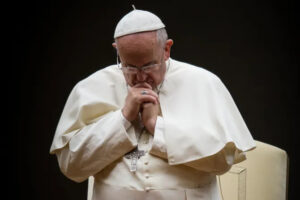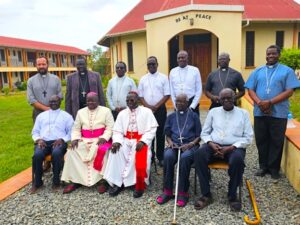ETHIOPIA: Getting the feel of the Ethiopian Rite at the opening mass of the 19th AMECEA Plenary
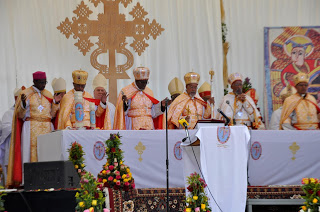
The 19th Plenary Assembly of the Association of Member Episcopal Conferences of Eastern Africa, (AMECEA) officially commenced on Sunday 15th with the Holy sacrifice of Mass at the Ethiopian Capital, Addis Ababa.
But the Holy Mass that followed the Ethiopian Rite was unlike any mass we are accustomed to in the AMECEA region, except in Eritrea where it is followed. The mass began with a liturgical dance by the Cistercian Brothers who marched to the forefront with drums and staff in hand. They danced to the tune of drums and the song they sung. Father Hailegabriel Meleku a Capuchin Friar later in an interview traced the origin of the dance to the 6th Century. He said it was Yared who composed the hymns and the dance.
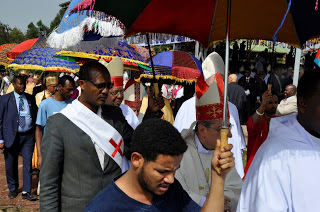
At the end of the liturgical dance, the main celebrant began the mass with a form of greeting, after which the rite of offertory begins. At this time the Eucharist is offered with the main celebrant selects the best bread and processes round the altar in his hand before it is wrapped up till the time of consecration. But this is unlike in the Roman Rite where the offertory comes after the readings.
The offertory was then followed by what is commonly referred to as the ‘Great Chant’, which ordinarily takes about 15 minutes
Since the Holy mass is literally chanted throughout, Fr. Meleku said that singing of hymns is usually limited to the beginning and at the end of the mass, but that another hymn could be added at the time of holy communion.

the Congregation at the beginning of the Opening Mass,
According to Ethiopian Rites, Blessings are imparted using
Ethiopian Cross as opposed to Latin Rites where Bishops bless By Hand
In a concelebrated mass, the co-celebrants are expected to use low voice while the main celebrant’s voice is expected to supersede the voice of the co-celebrants. And most importantly, Fr. Meleku explained that besides the main celebrant, co-celebrants are expected to be in the number of twos, fours, six, etc, thus creating an odd number of celebrants. “The total number of celebrants at the altar must always be in off numbers,” Fr. Meleku affirmed.
Another aspect of the Holy mass that is peculiar to the Ethiopian Rite is that the congregation always faces East. This according to Fr. Meleku signifies the direction of Jerusalem, where the son of God was born and redeemed us from.
Also, in the Ethiopian Rite, the altar servers are referred to as deacons (not ordained deacons). But during the opening of the Plenary Mass, this role was taken up by priests because the needed people who could chant the mass.
He further explained that the Catholic Church in Ethiopia uses both the Ethiopian Rite commonly referred to as the Oriental Rite and the Roman Rite. He said the Ethiopian Rite is being followed in four Epharchies (dioceses) in four, with Addis Ababa being the Archepharchy while nine other Vicariates follow the Roman Rite. In all, the Northern region follows the Ethiopian Rite while the Southern region follows the Roman Rite.
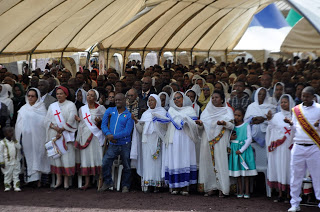
19th Plenary Opening Mass
The offertory was then followed by the readings, homily, the Creed, the preface and the consecration respectively. However, it was after the consecration that the “Kyrie” – Lord Have mercy was chanted, and according to Fr. Meleku, this takes between five to ten minutes. At the end of the kyrie, reception of the Holy Communion, which is often under both species.
Fr Meleku further explained that all through the mass, there are about 12 blessings namely at the beginning of the mass, before the gospel, the Kyrie, the dismissal and a couple of other spots where the celebrant is either blessing himself or the congregation.
As to how long the Ethiopian Rite mass takes, he said these varied. He said on Sundays and days of solemnity, mass often takes about four hours, while at ordinary times like week days, mass takes one hour. But he was quick to note that Christians are often more comfortable having longer mass than shorter ones. “One could be criticized for presiding over mass that takes a short time,” he said.
The Capuchin Friar, whose Order has more than 100 members serving in Ethiopia further explained that the readings followed in the Ethiopian Rite were different from those in the Roman Rite. Unlike in the Roman Rite where readings follow the liturgical calendar, he said in the Ethiopian, readings follow the seasons of the year as in Winter, Spring, Autumn and Summer.
Origins of Christianity in Ethiopia
According Fr. Meleku, Christianity in Ethiopia traces its roots to the Ethiopian Eunuch whom the Apostle Philip baptized in (Acts 8:27) in about 36AD He is believed to have spread Christianity after his return from a pilgrimage to Jerusalem. Being an official in King’s palace, Christianity is believed to have spread from the King’s palace. And from then till 330AD, Christianity was a state religion and unlike in other African countries it spread without bloodshed.
It was in 1974 that the Orthodox Christians broke away from Catholics. Today, Orthodox make 43% of the Christian population while Catholics make one percent (about 1million) of Ethiopia’s 110million people.
But when St. Justin De Jacobis, a Bishop belonging to the Congregation for Mission came to Ethiopia in 1839, he settled in Northern Ethiopia and adopted the Ethiopian Rite. Meanwhile, a Capuchin Cardinal Massia went to the South and introduced the Latin Rite. Thus, the work of the two missionaries gave birth to both the Ethiopian and the Latin Rites being followed in the country.
To this day, the Ethiopian Rite is followed in three Eparchies (dioceses) with the fourth i.e. Addis Ababa being an Arch Eparchy. Fr. Meleku explained that the Ethiopian Rite is followed in all parishes while adjustments can be made in convents where the Latin Rite is at times followed. Meanwhile, the Latin Rite is followed in eight vicariates with the ninth being an Apostolic Prefecture.
~End~
By Sr. Grace Candiru, MSMMC
